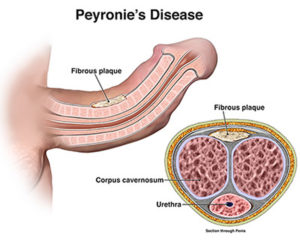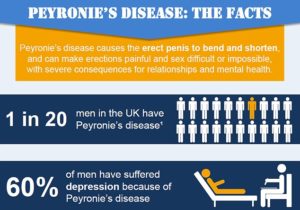Some men have a penis that curves to the side, upward or downward when erect. This is common, and a bent penis in most men isn’t a problem. Generally, a bent penis is only a cause for concern if your erections are painful or if the curvature of your penis interferes with sex.
Peyronie’s disease is a disorder in which scar tissue, called a plaque, forms in the penis—the male organ used for urination and sex. The plaque builds up inside the tissues of a thick, elastic membrane called the tunica albuginea. The most common area for the plaque is on the top or bottom of the penis. As the plaque builds up, the penis will curve or bend, which can cause painful erections. Curves in the penis can make sexual intercourse painful, difficult, or impossible. Peyronie’s disease begins with inflammation, or swelling, which can become a hard scar.
The plaque that develops in Peyronie’s disease is not the same plaque that can develop in a person’s arteries. The plaque seen in Peyronie’s disease is benign, or noncancerous, and is not a tumor. Peyronie’s disease is not contagious or caused by any known transmittable disease.
Early researchers thought Peyronie’s disease was a form of impotence, now called erectile dysfunction (ED). ED happens when a man is unable to achieve or keep an erection firm enough for sexual intercourse. Some men with Peyronie’s disease may have ED. Usually men with Peyronie’s disease are referred to a urologist—a doctor who specializes in sexual and urinary problems.
How does an erection occur?
An erection occurs when blood flow increases into the penis, making it expand and become firm. Two long chambers inside the penis, called the corpora cavernosa, contain a spongy tissue that draws blood into the chambers. The spongy tissue contains smooth muscles, fibrous tissues, spaces, veins, and arteries. The tunica albuginea encases the corpora cavernosa. The urethra, which is the tube that carries urine and semen outside of the body, runs along the underside of the corpora cavernosa in the middle of a third chamber called the corpus spongiosum.
An erection requires a precise sequence of events:
- An erection begins with sensory or mental stimulation, or both. The stimulus may be physical contact or a sexual image or thought.
- When the brain senses a sexual urge, it sends impulses to local nerves in the penis that cause the muscles of the corpora cavernosa to relax. As a result, blood flows in through the arteries and fills the spaces in the corpora cavernosa like water filling a sponge.
- The blood creates pressure in the corpora cavernosa, making the penis expand.
- The tunica albuginea helps trap the blood in the corpora cavernosa, thereby sustaining the erection.
- The erection ends after climax or after the sexual urge has passed. The muscles in the penis contract to stop the inflow of blood. The veins open and the extra blood flows out of the penis and back into the body.
What causes Peyronie’s disease?
Medical experts do not know the exact cause of Peyronie’s disease. Many believe that Peyronie’s disease may be the result of
- acute injury to the penis
- chronic, or repeated, injury to the penis
- autoimmune disease—a disorder in which the body’s immune system attacks the body’s own cells and organs
Injury to the Penis
Medical experts believe that hitting or bending the penis may injure the tissues inside. A man may injure the penis during sex, athletic activity, or an accident. Injury ruptures blood vessels, which leads to bleeding and swelling inside the layers of the tunica albuginea. Swelling inside the penis will block blood flow through the layers of tissue inside the penis. When the blood can’t flow normally, clots can form and trap immune system cells. As the injury heals, the immune system cells may release substances that lead to the formation of too much scar tissue. The scar tissue builds up and forms a plaque inside the penis. The plaque reduces the elasticity of tissues and flexibility of the penis during erection, leading to curvature. The plaque may further harden because of calcification––the process in which calcium builds up in body tissue.
Autoimmune Disease
Some medical experts believe that Peyronie’s disease may be part of an autoimmune disease. Normally, the immune system is the body’s way of protecting itself from infection by identifying and destroying bacteria, viruses, and other potentially harmful foreign substances. Men who have autoimmune diseases may develop Peyronie’s disease when the immune system attacks cells in the penis. This can lead to inflammation in the penis and can cause scarring. Medical experts do not know what causes autoimmune diseases. Some of the autoimmune diseases associated with Peyronie’s disease affect connective tissues. Connective tissue is specialized tissue that supports, joins, or separates different types of tissues and organs of the body.
How common is Peyronie’s disease?
Researchers estimate that Peyronie’s disease may affect 1 to 23 percent of men between 40 and 70 years of age.1 However, the actual occurrence of Peyronie’s disease may be higher due to men’s embarrassment and health care providers’ limited reporting.1 The disease is rare in young men, although it has been reported in men in their 30s.1 The chance of developing Peyronie’s disease increases with age.
Who is more likely to develop Peyronie’s disease?
The following factors may increase a man’s chance of developing Peyronie’s disease:
- vigorous sexual or nonsexual activities that cause microscopic injury to the penis
- certain connective tissue and autoimmune disorders
- a family history of Peyronie’s disease
- aging
Vigorous Sexual and Nonsexual Activities
Men whose sexual or nonsexual activities cause microscopic injury to the penis are more likely to develop Peyronie’s disease.
Connective Tissue and Autoimmune Disorders
Men who have certain connective tissue and autoimmune disorders may have a higher chance of developing Peyronie’s disease. A common example is a condition known as Dupuytren’s disease, an abnormal cordlike thickening across the palm of the hand. Dupuytren’s disease is also known as Dupuytren’s contracture. Although Dupuytren’s disease is fairly common in older men, only about 15 percent of men with Peyronie’s disease will also have Dupuytren’s disease.2 Other connective tissue disorders associated with Peyronie’s disease include
- plantar fasciitis––inflammation of the plantar fascia, thick tissue on the bottom of the foot that connects the heel bone to the toes and creates the arch of the foot
- scleroderma––abnormal growth of connective tissue, causing it to get thick and hard; scleroderma can cause swelling or pain in muscles and joints
Autoimmune disorders associated with Peyronie’s disease include
- systemic lupus erythematosus––inflammation and damage to various body tissues, including the joints, skin, kidneys, heart, lungs, blood vessels, and brain
- Sjögren’s syndrome––inflammation and damage to the glands that make tears and saliva
- Behcet’s syndrome––inflammation of the blood vessels
Family History of Peyronie’s Disease
Medical experts believe that Peyronie’s disease may run in some families. For example, a man whose father or brother has Peyronie’s disease may have an increased chance of getting the disease.
Aging
The chance of getting Peyronie’s disease increases with age. Age-related changes in the elasticity of tissues in the penis may cause it to be more easily injured and less likely to heal well.

